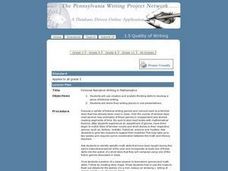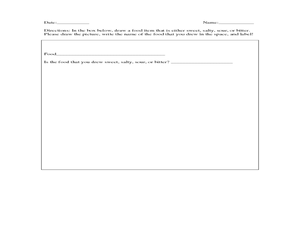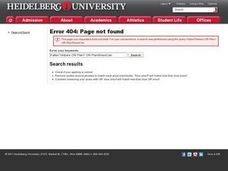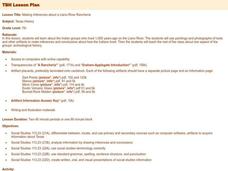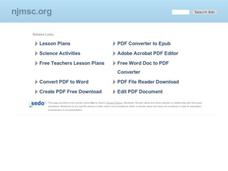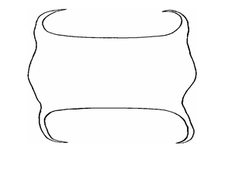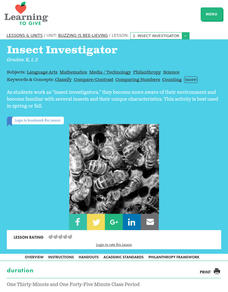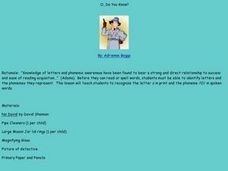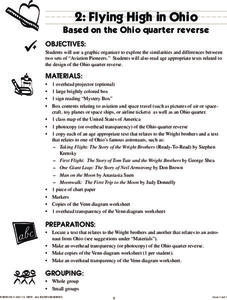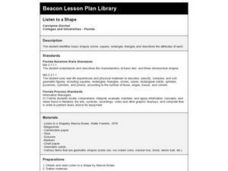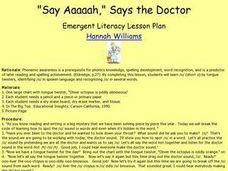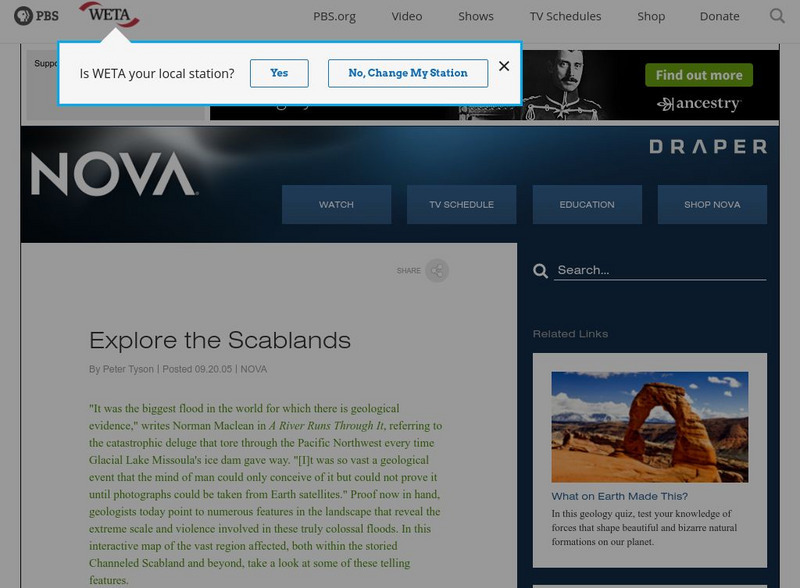Curated OER
Metals, Nonmetals, Metalloids
Students recognize that metals, nonmetals, and metalloids have common attributes. They Identify physical and chemical properties. Students define ores and identify where ores can be found.
Curated OER
Fictional Narrative Writing in Mathematics
Fifth graders discuss variety of fictional writing genres and connect each to familiar story that has been read, use creative and analytical skills to develop original piece of fictional writing that incorporates math skill, and share...
Curated OER
Lady of the Sky Amelia Earhart
Eighth graders explore the contributions of Amelia Earhart. In this Amelia Earhart lesson, 8th graders research Internet and print sources to find information about the aviation feats of Amelia Earhart. Students write...
Curated OER
Terrific Taste Buds
Young scholars explore descriptive writing by eating food in class. In this descriptive word lesson, students assess different foods in class such as jelly beans and utilize their vocabulary to describe the taste. Young scholars read the...
Curated OER
I Can Be An Archaeologist Book Share
Learners read and discuss the book, I Can Be An Archaeologist by Robert B. Pickering, and become archaeologists, themselves, as they examine, sort, and record items in a paper bag and trash from their classroom, as well as 2 others.
Curated OER
Water and Ice
Students examine how water changes state, from a liquid to a solid. In this water lesson students study the water cycle and how temperature and pressure effect it.
Curated OER
The Lesson: Space Exploration
Students explore space. In this current events activity, students visit selected websites to learn about NASA, Mars, the Seti Institute, and space exploration terminology. Students make space glossaries and their own telescopes.
Curated OER
Can You Name that Town
Students, after becoming familiar with different names of towns in Arkansas, practice using a map grid and map index.
Curated OER
Making Inferences About a Llano River Rancheria
Seventh graders research the Indian groups that lived 1,000 years ago on the Llano River. They analyze paintings and photographs of tools and artifacts, develop inferences and conclusions about how the Indians lived, and present the...
Curated OER
Pioneers In Space
Young scholars discover the meaning of the word pioneer by using a variety of different activities. They are introduced to some of the pioneers of aviation in Ohio. They use coins and conduct research about some of the persons who...
Curated OER
Skates
Students gain understanding of structure, characteristics, and basic needs of living things and their role in world, identify parts of skate, observe details of skate's body and skate egg case, and identify unique characteristics of skates.
Curated OER
Order Out of Borders
Students examine the differences between natural and man-made borders by investigating the Texas quarter. They create clay models of the state of Texas.
Curated OER
Insect Investigator
Students examine and identify common insects. They observe these insects in their environment and keep track of how many they see. They use magnifying glasses and special hats to get into the role of an inspector.
Curated OER
How Does it End?
Students listen to the first part of a story, use drawing software, such as Paint or AppleWorks, to draw, or write and draw, their own imaginary endings to the story. They practice their mouse and computer navigation skills. They share...
Curated OER
O, Do You Know?
Pupils identify the short /o/ sound in this lesson. They discover that the "o" is shaped like a magnifying glass, and are "detectives" looking for the /o/ sound in words. They listen to "No, David!" and identify the short /o/ sound...
Curated OER
Flying High in Ohio
Students use a Venn diagram to explore the similarities and differences between two sets of "Aviation Pioneers." They read age appropriate texts related to the design of the Ohio quarter reverse. They examine the quarter and locate Ohio...
Curated OER
Listen to a Shape
First graders identify basic shapes (circle, square, rectangle, triangle) and describes the attributes of each. They use magazines to find examples of each shape, and then make a collage.
Curated OER
Say Aaaaah, Says the Doctor
Students explore the short /o/ sound using tongue twisters. They identify the /o/ sound in spoken language and recognize the /o/ in written words. Students practice writing the letter o. They spell words with the /o/ sound and they read...
Curated OER
Cool! Awesome! What is it?
Learners infer what a mysterious object is in a photo. In this inference lesson, students practice their scientific skills to identify what they see. Learners enjoy solving the mysterious identity of objects and extending their knowledge...
Curated OER
Celebrating Saturn and Cassini
Students use their notes from previous lessons to write a paper on Saturn or Cassini. They share their writings with the class. They discover how everyone has a different learning style.
Curated OER
The Beautiful Bouncing Ball
Students practice recognizing a letter and its phoneme by utilizing the alphabetic principle while working with and identifying the sounds of /b/. They assess a big book, objects in the room, a timer and the tongue twister, "Billy...
Curated OER
Bon Voyage - Literature Travel Unit
Eighth graders locate and interpret information about the culture of another country using multi-media tools. Students read and interpret literature about characters and cultures from a foreign country. Students create a travel guide...
PBS
Nova: Mystery of the Megaflood
This interactive site provides geologic evidence for one of the world's largest prehistoric floods. Nova's interactive map has numerous pictures of the Scabland's geologic features formed when Glacial Lake Missoula's ice dam gave way and...

